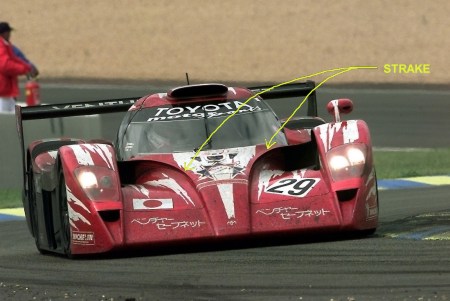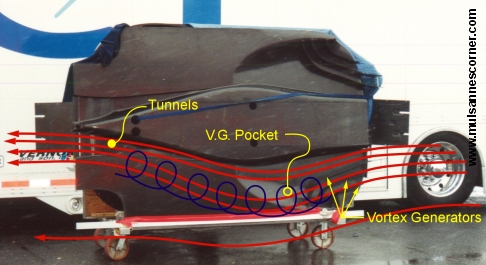 A
number of years ago I wrote a piece describing vortex lift and the
possibility
of its application on the Toyota GT-One. Since that time I've
had
the opportunity to speak with a number of aerodynamacist about the
idea.
More recently, in email conversations with Juha Kivekas, I've have come
to some different conclusions regarding the principle in general and
the
Toyota GT-One specifically. To recap, my thought was that the
Toyota
GT-One was utilizing the strake detail (image left) to generate a
vortex
that would travel the length of the cockpit and flow under the wing
enhancing
the low pressure side efficiency.
A
number of years ago I wrote a piece describing vortex lift and the
possibility
of its application on the Toyota GT-One. Since that time I've
had
the opportunity to speak with a number of aerodynamacist about the
idea.
More recently, in email conversations with Juha Kivekas, I've have come
to some different conclusions regarding the principle in general and
the
Toyota GT-One specifically. To recap, my thought was that the
Toyota
GT-One was utilizing the strake detail (image left) to generate a
vortex
that would travel the length of the cockpit and flow under the wing
enhancing
the low pressure side efficiency. Vortex
lift is seen in a number of applications in aircraft and in
nature.
This principle is what makes, of all things, insects able to
fly.
Aerodynamic theory states that as an aerodynamic surface gets smaller,
it becomes less efficient at generating lift. An insect's
wing generates
a vortex on the top surface (the low pressure side) which greatly
increases
the surface's ability to produce lift. Modern supersonic
combat aircraft
use this idea to increase subsonic aerodynamic performance.
The strakes
near the cockpit of a F-16 or F/A-18 generate vortices that run over
the
top side of the wing creating more efficient lift by inducing higher
speed
and therefore lower pressure. But these vortices aren't
present in
normal flight, and are only generated when the aircraft achieves a high
angle of attack while either maneuvering or landing. Juha
Kivekas
points out, "in these conditions the flow stays attached
at the
incredible angles because of the vortex energy mix
phenomenon". Or,
stated more simply, flow separation is delayed by the rotating vortices
which mixes the boundary layer flow and the main stream flow imparting
energy to the more stagnant boundary layer.
Vortex
lift is seen in a number of applications in aircraft and in
nature.
This principle is what makes, of all things, insects able to
fly.
Aerodynamic theory states that as an aerodynamic surface gets smaller,
it becomes less efficient at generating lift. An insect's
wing generates
a vortex on the top surface (the low pressure side) which greatly
increases
the surface's ability to produce lift. Modern supersonic
combat aircraft
use this idea to increase subsonic aerodynamic performance.
The strakes
near the cockpit of a F-16 or F/A-18 generate vortices that run over
the
top side of the wing creating more efficient lift by inducing higher
speed
and therefore lower pressure. But these vortices aren't
present in
normal flight, and are only generated when the aircraft achieves a high
angle of attack while either maneuvering or landing. Juha
Kivekas
points out, "in these conditions the flow stays attached
at the
incredible angles because of the vortex energy mix
phenomenon". Or,
stated more simply, flow separation is delayed by the rotating vortices
which mixes the boundary layer flow and the main stream flow imparting
energy to the more stagnant boundary layer. Vortex
lift itself isn't unique as it is used through out motorsports,
primarily
to enhance bottom side downforce generation (image, Lola Champ Car
underfloor).
One problem is that vortices come with an inherent drag penalty that
can
dramatically reduce their effectiveness, especially
when used in
the top side flow regime. Vortices are also very fragile in
their
nature and therefore difficult to utilize. Which gets us back
to
the Toyota GT-One. The location of the strake on the GT-One
is upstream
of a low pressure area created by the shape of the cockpit.
Any vortex
generated would not have a particularly long life as it would probably
be very small to start with and would easily reattach due to that
suction
point. Secondly, the vortex length necessary to effect the
rear wing
would be problematic as longitudinal vortices burst very
quickly.
Given the distance and the environment (various low pressure areas
created
by the cockpit, bodywork, etc.), it is doubtful that any vortex
generated
at the front of the car would survive to effect the rear.
Vortex
lift itself isn't unique as it is used through out motorsports,
primarily
to enhance bottom side downforce generation (image, Lola Champ Car
underfloor).
One problem is that vortices come with an inherent drag penalty that
can
dramatically reduce their effectiveness, especially
when used in
the top side flow regime. Vortices are also very fragile in
their
nature and therefore difficult to utilize. Which gets us back
to
the Toyota GT-One. The location of the strake on the GT-One
is upstream
of a low pressure area created by the shape of the cockpit.
Any vortex
generated would not have a particularly long life as it would probably
be very small to start with and would easily reattach due to that
suction
point. Secondly, the vortex length necessary to effect the
rear wing
would be problematic as longitudinal vortices burst very
quickly.
Given the distance and the environment (various low pressure areas
created
by the cockpit, bodywork, etc.), it is doubtful that any vortex
generated
at the front of the car would survive to effect the rear.
Though ultimately vortices could be used for the benefit of top side race car aerodynamics, specifically in drag reduction. Juha Kivekas sums it up best, "It certainly is possible to use longitudinal vortices to fill the wake of the cockpit bulge. This could be done using delta wings on the sides of the cockpit. And actually there have been studies on lorries where angled delta wing were used near the trailing edge of the cab and have been found to increase base pressure; that is, to reduce drag. The vortices steal energy from the main flow and mix it into the wake flow and thus reduce the effective length of the wake. This is Mother Nature's explanation, we simply call it reduced drag."
